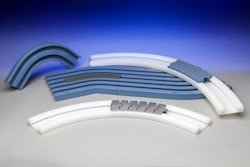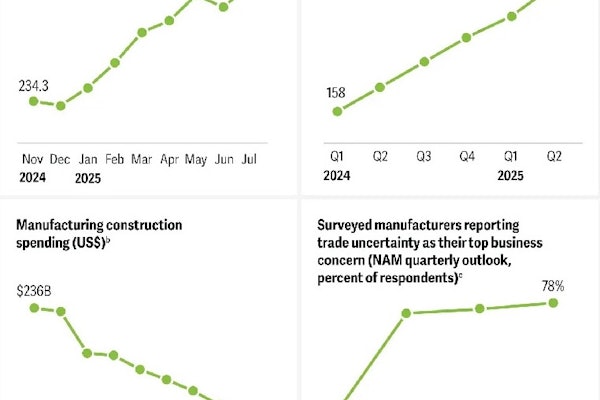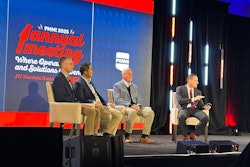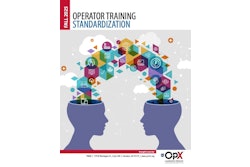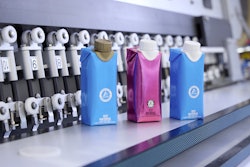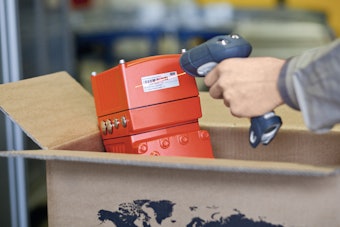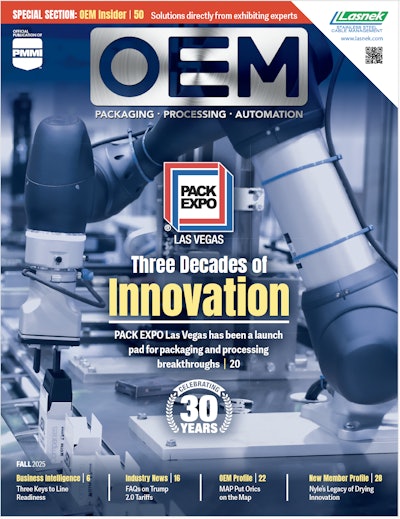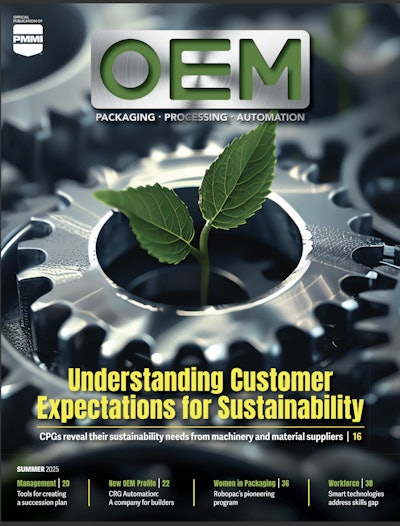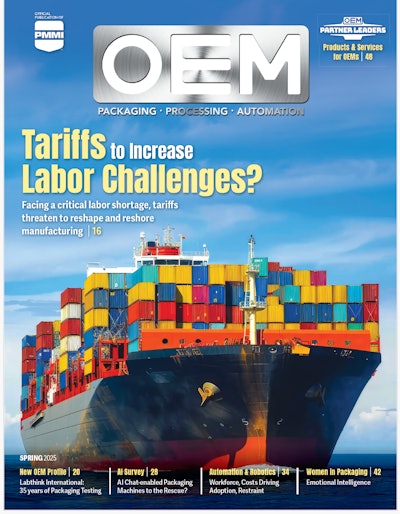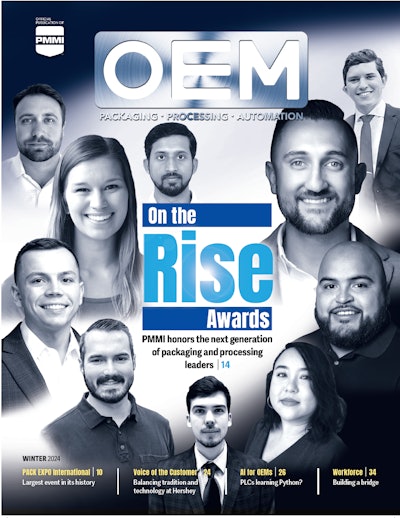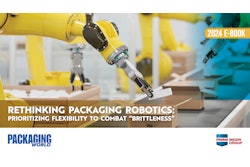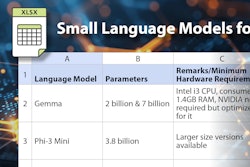Eight years ago, Rick Allegretti, ARPAC president and CEO realized that one traditional manufacturing method would not satisfy the portfolio of secondary packaging products ARPAC was offering. In some ways, the company was a victim of its own success, as its highly varied product line meant that one-size-fits-all manufacturing didn’t exist. To complement the need for Engineered-to-order (ETO), Build-to Stock (BTS), Build-to-order (BTO) and Assembly-to-Order (ATO) products, ARPAC implemented strategic focus factories. Today ARPAC operates six so-called “focus” factories designed for manufacturing the different product line needs in a lean manufacturing environment suited uniquely for each of the ETO, BTS, BTO and ATO products.
Division of labor for integration innovation
ARPAC built its first focus factory—exclusively for the semiautomatic stretch wrapper machines—that would become the operating model for a company-wide method of production. Investments included a robotic welder and a powder-coat paint booth. The factory aimed to move small parts in high volume, with quick delivery and high quality goals. It now takes hours, instead of weeks, to assemble to order and ship many of its lower-complexity-level machines. These machines are built to sub-assembly level, generally 50-75 percent complete, managed via kanbans, and finally assembled to order when the customer places an order. Inventory turns, lead times, quality and on time shipments are all improved using this cellular manufacturing approach.
More importantly, by freezing the bills of materials (BOMs) and standardizing assemblies, engineering resources were freed up to tackle more complex problems and form the OEM-Integrator model.
The primary factor that defines each focus factory is where it stands on the sophistication vs. manufacturing velocity continuum. For less complex products like stretch wrappers, the focus factory operates like a Ford assembly line and output is high. But as sophistication and custom engineering increase, as is required in integration, sheer volume of output decreases. On complex machines and full, integrated packaging, a team of experts is enabled to work together in close proximity within the integration focus factory, collaborating with one another to solve the most complex automation challenges that come with line integration. It’s a matter of striking the right balance of speed and sophistication for each focus factory.
At the other end of the continuum, in the engineered-to-order focus factories, custom projects have a significant amount of both mechanical and electrical engineer content. As many as 250 machines per year are derived from standard, standalone machines with the addition of custom subassemblies. Though these machines are built from the same sub-assembly building blocks as the standard machines, they begin a custom journey thereafter. Each product is different in size, shape, speed, weight, friction, etc. Thus, the material handling and product control aspect of these automated machines need to be carefully designed. A unique BOM is released by engineering for each specific order.
Sophistication level isn’t the only factor dividing focus factories. Some are simply practical focus areas. For instance, ARPAC has one focus factory for corrugated – workers efforts there are concentrated on working on corrugated machinery systems instead of film. The delineation of individual focus factories includes attention to the product group that’s being handled. The package type (case/tray/film) determines the people employed in any location, keeping pockets of expertise strategically deployed. This way, ARPAC maximizes efficiency and flexes its lean manufacturing muscles.
Vertical integration makes it possible
With a full CNC machine shop, complete with two 4KW CO2 lasers that can cut through ½” of steel CNC press brakes, a range of CNC machines, and a high-speed robotic welder, the company manufactures, in-house, all of the components necessary to build its entire cache of secondary packaging machines, and ultimately has the ability to integrate all of those components on a complete secondary packaging production line.
This gives ARPAC unique control over everything from raw material flow into the machine shop to finished packaging machines and complete system out to the shipping dock.
This vertical integration, coupled with the multitude of aforementioned focus factories, churning out multiple product lines at multiple levels of sophistication, make ARPAC unique as a pioneer of the OEM-Integrator model.
Within this model, the manufacturer integrates in-house, pulling from its own deck of cards by using its own machines to constitute the integrated systems. The integration factory operates as a big league team, calling up necessary components and machines from the other focus factories to plug them into complete, custom packaging lines.
There are several benefits to the OEM-Integrator model. Brian Ormanic, lead robotic and integration engineer, says ARPAC has been able to create a more harmonious line with fewer integration challenges. He compares their in-house process to other integrators, who often are in the position of “stringing disparate lines, disparate machines, together via PLC controls and hoping to make everything work. Hope is not a very good strategy, so we approached it differently.”
Allegretti also believes that to be successful over the long-term, OEMs as integration solution providers, need to be experts in the products they integrate. This allows for a faster solution from concept to working reality. With its breadth of end-of-line products, ARPAC avoids getting dragged into the thorny interactions that often arise when integrators work with multiple OEMs.
That said, ARPAC does incorporate other packaging OEM’s machinery, as an OEM-Integrator not just an integrator, understanding the challenges that other OEMs face. The control platform is one area Allegretti believes comes together particularly smoothly.
The OEM-Integrator model enables ARPAC to conduct complete packaging line factory acceptance tests (FATs), on its own factory floor, prior to shipping to the customer, for complete packaging lines in one location. This testing makes it possible to simulate the conditions under which a packaging line will operate including the interactions between machines and processes. ARPAC customers report that this strategy has shortened their time to production by 20-30 percent, reduced costly startup issues, accelerated the proficiency of their operators, and lowered Total Cost of Ownership (TCO).
Any integrator can tell horror stories of projects that involved multiple manufacturers. Each manufacturer has its own engineering group, and the process of establishing clear communication with all the relevant players within each organizational ‘silo’ quickly becomes a logistical nightmare. “It’s all our equipment,” says Gary Ehmka, VP of sales and marketing. “We’re not pointing fingers at other manufacturers. We take full responsibility so should any problems or issues arise, we address and rectify them without hesitation."
Many manufacturers do not have a broad enough product line to successfully execute a strategy as an OEM-Integrator. ARPAC’s ability to base solutions exclusively on its own products has given the manufacturer a degree of pricing flexibility. “We are big believers in being vertically integrated,” Allegretti says. “It’s the range of our equipment and the infrastructure of both people and process, that allows us unique position as an OEM-Integrator.”
Allegretti believes the trend in the needs of CPG (consumer packaged goods) is on his side. End users simply have to do more faster and with less internal resources.
More end users are re-examining their integration processes. He says CPGs, OEMs, brand owners and end users in general are asking, “We don’t have as many engineers as we used to have. Instead of hiring an integrator to go buy the equipment, why don’t we hire the OEM to integrate the equipment?”
Focus on lean manufacturing
As the lean-friendly focus factory model demonstrates, lean manufacturing is a big part of ARPAC’s mission. Allegretti first started thinking about lean manufacturing 25 years ago while working for SK Tools. “Back then, the whole idea was one piece flow. How do you create cells? How do you really work in process? How do you link equipment together so you don’t have to move big piles of things around?” he wondered.
Today, people think of “lean” in different ways, from value stream mapping or visual manufacturing to cellular manufacturing or kanban. The lean tool kit is deep, and walking around the ARPAC plant, one finds an array of lean processes in progress. Most visibly, television monitors throughout the facilities keep everyone abreast of progress and status as a cornerstone of visual manufacturing. Kanban is also employed, meant to effectively communicate status, highlight slowdowns, and eliminate bottlenecks.
Cellular manufacturing is the foundation in the lean assembly of the semiautomatic stretch wrapper, which has been designed to be modular to complement the cellular manufacturing flow. All parts are kept in strategically considered places in accordance with lean best practices, and reordered utilizing Kanbans by the assemblers. The most commonly used parts are placed in the most accessible spots, so all the parts an operator needs are right there at his or her fingertips. The inventory of nuts and bolts and other high use/low value parts is managed and replenished as needed by ARPAC’s suppliers so inventory levels never need be a concern of the operations personnel. This VMI (vendor managed inventory) program is deployed in all of ARPAC’s focus factories. In that way, ARPAC gets maximum efficiency from the operators and assemblers in these standardized focus factories and improved inventory turns.
Thanks in part to lean principles, the semiautomatic stretch machine focus factory is the most prolific of ARPAC’s focus factory stable. The company completes as many as 15 machines per week. Of the roughly 1,000 machines shipped by ARPAC per year, nearly 700 come out of this focus factory. That’s a well-oiled machine, with the fat fully trimmed.
“Lean manufacturing is really elimination of waste,” Allegretti says. “Waste is different depending upon where you are sitting and the way you are going about your business. You can’t eliminate it completely, but you can take a pretty big bite out of it.”


